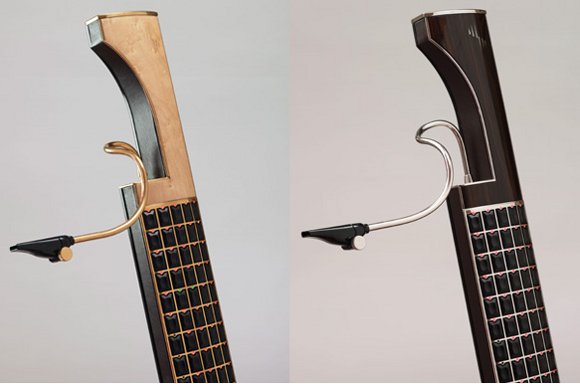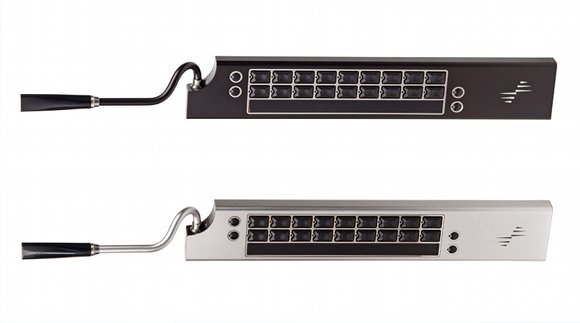I don’t know if it’s “the most revolutionary new musical instrument of the last 60 years,” but let’s be clear on one thing: the Eigenharp Alpha is utterly, beautifully insane. It combines breath and finger input in a bassoon form factor, but with quite a lot more physical control, a computer connection, and no internal sound source of its own. The breath input comes from a crooked tube as on a bassoon, with finger input in a touch strip, a fretted, light-up keyboard, and keys that have their own various forms of expression. Launched yesterday in London, the Eingenharp is getting a lot of attention. (And yes, some of you spotted signs of its launch all the way back in June, to which I say – I’m sorry I’m so late to the party.)
From BBC: Do you drum it, strum it or stroke it?

I hope to speak to the creators soon. Already, I see some indications that there are equal parts genius and madness here. The controller itself, even in the bizarre bassoon form factor, has an extraordinary amount of control, with high-resolution keys, percussion keys, elaborate control arrangements that can adjust tone or record samples, and extremely precise breath and touch. At £3,950, many computer musicians accused of “knob twiddling” by the creators probably won’t be able to afford the top-of-the-line model, but I do believe an instrument like this can easily, fairly cost this much, it’s a cost reasonable for musical instruments – and there is a £349 “Pico” edition for mortals.
There’s some madness, too, however. For the “instrument of the future,” the creators appear to have chosen MIDI, via USB, in place of a modern control protocol. Then, they plug the instrument into proprietary Mac software. (A Windows version is expected early next year.) There are software models of a Cello, a Clarinet, and a Synth, but there are also gigs of samples oddly loaded into SoundFont format. Given the futuristic ambitions and the sky-high price, closed software and antiquated I/O seem puzzling to me. I’m also skeptical of the approach here of piling on as many controllers as possible.
CORRECTION – CORRECTION! Yes, indeed – proprietary software and the limitations of MIDI wouldn’t make any sense – and apparently the creators agree. So the software will be open sourced, as will their custom-designed protocol. I’ve got all the details – required reading for anyone working on expressive instruments.
But don’t get me wrong. I think this fascinatingly bizarre instrument is worth exploring. The hardware design looks exceptionally luxurious, and there is some genuine design innovation in the controller the likes of which we’ve never seen in an instrument beyond a prototype or two.
Oh, and yes, I already want the Pico – and I think the Pico’s fewer controls may actually make more sense.
Basic specs:
Video of the key action, among others collected on YouTube:
The “Alpha,” the flagship:
- 120 keys, plus 12 percussion keys. (Wait — 120? Yes, you read that right.)
- Two strip controllers, one on each side.
- Breath pipe and mouthpiece.
- 11-bit resolution (2048 values) in the keys and strip controllers, 12-bit resolution (4098 values) for breath.
- Internal audio interface with mic pre, converters, and headphone out – so you need to carry this and a computer, but not this, a computer, and an audio interface.
- A “Base Station” with inputs for expression pedals and foot switches, which also contains the USB connection. This connects to a floor spike on which the instrument rests.
http://www.eigenlabs.com/alpha/
The Pico:
- 22 keys (18 for playing, four mode switches).
- Keys work via direct pressure and lateral pressure in both directions, as on the Alpha.
- Breath pipe.
- Strip controller.
- Same resolution: 11-bit keys, 12-bit breath.
- £349.
http://www.eigenlabs.com/pico/

To be honest, I’m quite a lot more interested in the Pico, not because I think cheaper is better, but because I’m curious whether you can’t be just as expressive with the more limited set of controls as with the kitchen sink approach of its big brother. After all, 22 keys is roughly the number you’d find on most reed instruments, including the Bassoon. True, the piano has 88 keys, but it also doesn’t really have anything else – and it’s able to have so many because of its form factor.
In fact, I’m sorry, but I love the Pico. It looks friendly, it looks portable, it isn’t terrifying-looking like the Alpha, and it seems it’d be more at home in a variety of musical venues than the Alpha. Sometimes less is more. Let’s see if I prove to be correct.
The software, though I hope you could also customize your own software rig using the MIDI input:
- Modular, allowing the routing of control inputs, sound sources and samples, loopers, and synthesis and effects.
- SoundFont oscillator.
- Physical models of the clarinet, cello.
- AU host for adding your own plug-ins. (And yes, this is where I think you’ll have the most fun.
- A system for triggering events, takes, key, and mapping scale.
- An interactive arrangement system for step sequencing.
- Oddly, an extensive Steinway D multi-sample. On the other hand, for years we’ve all have been playing bassoon and other reed samples on the keyboard, and in organ form for centuries, so now the reed instrument gets its revenge.
Source: Eigenlabs software specs.
The instrument’s creator, John Lambert, repeats the maxim heard at new instrument design conferences: “We’ve got pretty fed up with watching people twiddle knobs on stage.” Naturally, that means… turning to the Bassoonist, that sex icon of the orchestra? I’ll run with it.
One other tidbit from that article:
He says there is one high-profile musician who is about to take delivery of an Eigenharp, but won’t give any names.
Yeah, Herbie Hancock, we know it’s you. (Okay, they are an English company, so maybe it’s an English celeb, but really the question is whether Herbie is who they mean, or whether he’s filling out the pre-order as we speak. He’s like what we would all be like if we had a budget.)
Anyway, consider this a first look. I hope to get closer to the actual instrument soon.